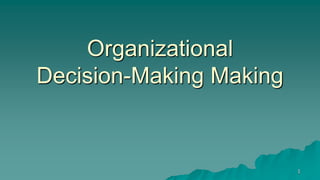
OrgDecisionMaking.ppt
- 2. 2 Organizational Decision Making Decisions: Choices made amongst two or more alternatives Is defined as the process of identifying and solving problems (e.g. “Toyota-sticky accelerator” , “Amazon-Kindle e-reader”) Has two stages: problem identification and problem solution Decisions vary in complexity continuum and are categorized as programmed (routine) or non programmed (non-routine)
- 3. 3 Individual Decision Making Rational Model: consistent, value-maximizing choices within specified constraints (e.g. Pro-Con) Bounded Rational Perspective: constructing simplified models that extract essential features from problems without capturing all their complexity Satisficing Vs Optimizing: seek solutions that are satisfactory and sufficient Combine rationality with intuition (distilled experience leads to unconscious prompting)!
- 4. 4 Steps in the Rational Approach to Decision-Making Monitor Decision Environment Implement Chosen Alternative Define Decision Problem Specify Decision Objectives Diagnose Problem Develop Alternative Solutions Evaluate Alternatives Choose Best Alternative 1 2 3 4 5 6 7 8
- 5. Bounded Rationality 5 People do not optimise in the “rational” manner described by economists. They conduct a less than complete search for alternatives. They then choose an option that meets a certain threshold of satisfaction. That is, they Satisfice, not Optimise. This may be a generally efficient strategy, given time & resources.
- 6. 6 Trade-off Trade-off Trade-off Trade-offs During Non-programmed Decision-Making Personal Constraints: Desire for prestige, success; personal decision style; and the need to satisfy emotional needs, cope with pressure, maintain self-concept Organizational Constraints: Need for agreement, shared perspective, cooperation, support, corporate culture and structure, ethical values Bounded Rationality: Limited time, information, resources to deal with complex, multidimensional issues Decision/ Choice: Search for a high-quality decision alternative Trade-off Trade-off
- 7. 7 Organizational Decision Making Management Science Approach Carnegie Model Incremental Decision Process Model Garbage Can Model
- 8. 8 Management Science Approach Is the analog to rational model of individual decision making Came in to being during WW II: Used mathematical and statistical techniques to urgent and large scale military problems e.g. Missile trajectory, aiming battleship guns Same approach diffused in to corporations and big businesses Used in quantitative data analysis, operations research Use in situations where variables are measurable
- 9. 9 Carnegie Model Based on bounded rationality approach to individual and organizational decision making Organizational level decisions involved many managers and final choice was based on a coalition (alliance) among managers Reason being organizational goals are ambiguous and operative goals are inconsistent Managers tend to be rational but are constraint by time, resources and mental capacities. So they form coalition
- 10. 10 Choice Processes in the Carnegie Model Hold joint discussion and interpret goals and problems Share opinions Establish problem priorities Obtain social support for problem, solution Adopt the first Alternative that is acceptable to the coalition Conduct a simple, local search Use established procedures if appropriate Create a solution if needed Managers have diverse goals, opinions, values, experience Information is limited Managers have many constraints Uncertainty Coalition Formation Search Satisficing Conflict
- 11. 11 The Incremental Decision Process Model Places emphasis on structured sequence of activities undertaken from the discovery of the problem to its solution. Major organization choices are usually a series of small choices that combine to produce the major decision. Organizations move through several decision points and may hit barriers along the way called ‘decision interrupts’ which means organization has to look for new alternatives. Example: Gillette-Mach3
- 12. 12 The Incremental Decision Process Model · Identification Phase: problem recognition – Recognition (becoming aware of the problem & the need to take the decision) – Diagnosis (systematic & detailed if time permits or quick & immediate) Development Phase: solution identification – Search (look for alternatives within the organizations repertoire of solutions) – Screen (eliminate what does not apply) – Design (if the above is not applicable design a custom made solution)
- 13. 13 The Incremental Decision Process Model cont. Selection Phase: choosing the solution – Judgment: (when final choice falls on a single decision maker & judgment is based on experience) – Analysis: (alternatives evaluated in a more systematic manner like management science techniques) – Bargaining: (happens when selection involves group of decision makers, so conflict happens, solved through coalition of carnegie model) – Authorization: (when decision is finally accepted authorization takes place) Dynamic Factors: (refer to the feedback loops as a result of decision interrupts
- 14. 14 Garbage Can Model of Decision-Making Deals with the pattern or flow of multiple decisions as opposed to how a single decision is made (as in Incremental and Carnegie models) Are applied to organic structures operating in highly uncertain environment Termed as organized anarchies
- 15. 15 Learning Organization Decision Process When Problem Identification and Problem Solution Are Uncertain When problem identification is uncertain, Carnegie model applies Political and social process is needed Build coalition, seek agreement, and resolve conflict about goals and problem priorities When problem solution is uncertain, Incremental process model applies Incremental, trial-and-error process is needed Solve big problems in little steps Recycle and try again when blocked PROBLEM IDENTIFICATION PROBLEM SOLUTION
- 16. 16 Garbage Can Model: Characteristics Decision process is not seen as a sequence of steps beginning with a problem and ending with a solution A solution may be around when there is no problem A problem may have no solution Garbage can is a mix of problems, potential solutions, capabilities of participants and choice opportunities
- 17. 17 Garbage Can Model: Consequences Solutions may be proposed even when problems do not exist Choices are made even without solving problems Problems may persist without being solved A few problems are solved
- 18. 18